Abstract
Even the concept of Responsible Research and Innovation (RRI) has not been clearly explained in the scientific literature, it is more and more frequent used, being promoted in the European Union policies and programs in Science and beyond. According to the Horizon 2020 initiative, launched by European Commission in 2014, RRI underpins several European projects and represents one of the current images of the connection between Science and Society, in the EU vision. Anyway, one of the targeted issues is related to make a transparent engagement of all the societal actors in research and innovation aspects, through promoting science education and facilitating the access to scientific knowledge. However, at the global level, RRI has implications on designing and implementing research and innovation policies that lead to: hiring the society in research and innovation; increasing the access to scientific results; ensuring gender equality in the research area; providing an ethics of researcher / research, and in compliance with current laws relating to ethics; promoting science education at formal and non-formal levels. The paper illustrates the feed-back of the teachers who participated to several Workshops dedicated to promote RRI in Science education, organized in the frame of the European FP7 project entitled: “
Keywords: Responsible Research and Innovationteachers’ feedbackScience teachingScience educationENGAGE project
Introduction
In the latest period, a big number of papers reported a massive decline of students’ motivation to learn Science (Gorghiu, & Gorghiu, 2014). A lot of countries tried to make different changes in their policies and curricula, but also in the ways of teaching used in Science education, in order to increase the students’ interest for science and technology. Those changes are based on the fact that a good understanding of science is considered to be a necessary skill for every European citizen (Vassiliou, 2011). Since many European countries were concerned about the sharp decrease of the students’ performances in learning science, as it was emphasized by different international surveys, this information led to the adoption in 2009 of an EU-wide benchmark which states that “by 2020 the share of 15-year-olds with insufficient abilities in reading, mathematics and science should be less than 15 %” (ET 2020, 2008).
In order to understand the causes of declining of the students’ interest in learning different sciences, various reports have been realized to the EU level, that illustrate comparative analysis of approaches to science teaching in Europe and aim to contribute to a better understanding of those factors. Most of those reports revealed that it is compulsory to change completely the way of presenting and teaching the scientific issues in order to make them more attractive in the eyes of young learners.
In the last decades, many studies related to Science education presented different analysis and results of different changes concerning policies, curricula, content and teaching strategies implemented in Science lessons. While society faces today big problems concerning huge environmental imbalances that led to climate changes and unexpected wild phenomena, it is a huge need to have more scientists prepared to face and solve those massive problems. In this context, questions like “How is it possible to raise the students’ motivation, to increase their interest in science?”, “Can Science lessons be successful in reaching all students, as well as educating future scientists?” or “Which are the best ways to promote Science, with the view to increase the number of students interested by it?” are now posed by the Science educators from all over the world in their aim to get more learners that will choose a scientific carrier. Thus, like all over the world, EU Commission establish different policies and established different frameworks for promoting Science and its connection with the societal problems became main priorities. Now, the current program that promote “
Responsible Research and Innovation in Science Education and the ENGAGE Project
Responsible research and innovation became actually a very important issue to motivate the use of new technologies for social benefit, to avoid the loss of any technological advance, to decrease the fear of unintended and irreversible consequences and to prevent disasters or catastrophic effects of scientific results and technological products (Sutcliffe, 2011).
There were defined six key aspects of RRI (Sutcliffe, 2011): a)
Since one of the key activities of RRI is Science education, and RRI is one of the priorities of the European Commission policy, there are many FP7 projects financed by EU that promote RRI in formal and informal / non-formal education of Sciences. One of those projects is the ENGAGE project (“
A number of fourteen partners from thirteen countries like UK, France, Spain, Germany, Greece, Norway, Nederland, Romania, Switzerland, Lithuania, Cyprus, Italy and Israel trying to promote - in the frame of the ENGAGE project - different interactive teaching strategies and modern tools to make Science lessons more attractive for the young students. All the ENGAGE materials proposed to the Science teachers start from the Science news appeared in the media and promote different methods to investigate the reality, connecting also the societal problems with the scientific topics. Thus, the main issue of the ENGAGE materials is to make students to identify and test alternative solutions for solving different problems, which allow them to think, talk and make responsible decisions.
In this context, Science teachers has to understand the philosophy of RRI concept, to be capable to introduce this kind of materials in the regular Science lessons and to promote the RRI dimensions in teaching a certain scientific topic. Thus, a 3-stages continuous professional development model (
In order to help the teachers to pass through the 3-stages CPD model, the project partnership decided to organize face-to-face workshops and on-line courses. Because the most important think was to introduce the RRI concept and explain to the teachers the relation between the RRI key aspects and the teaching materials designed in the frame of the ENGAGE project, the partnership decided to promote the 1st stage (
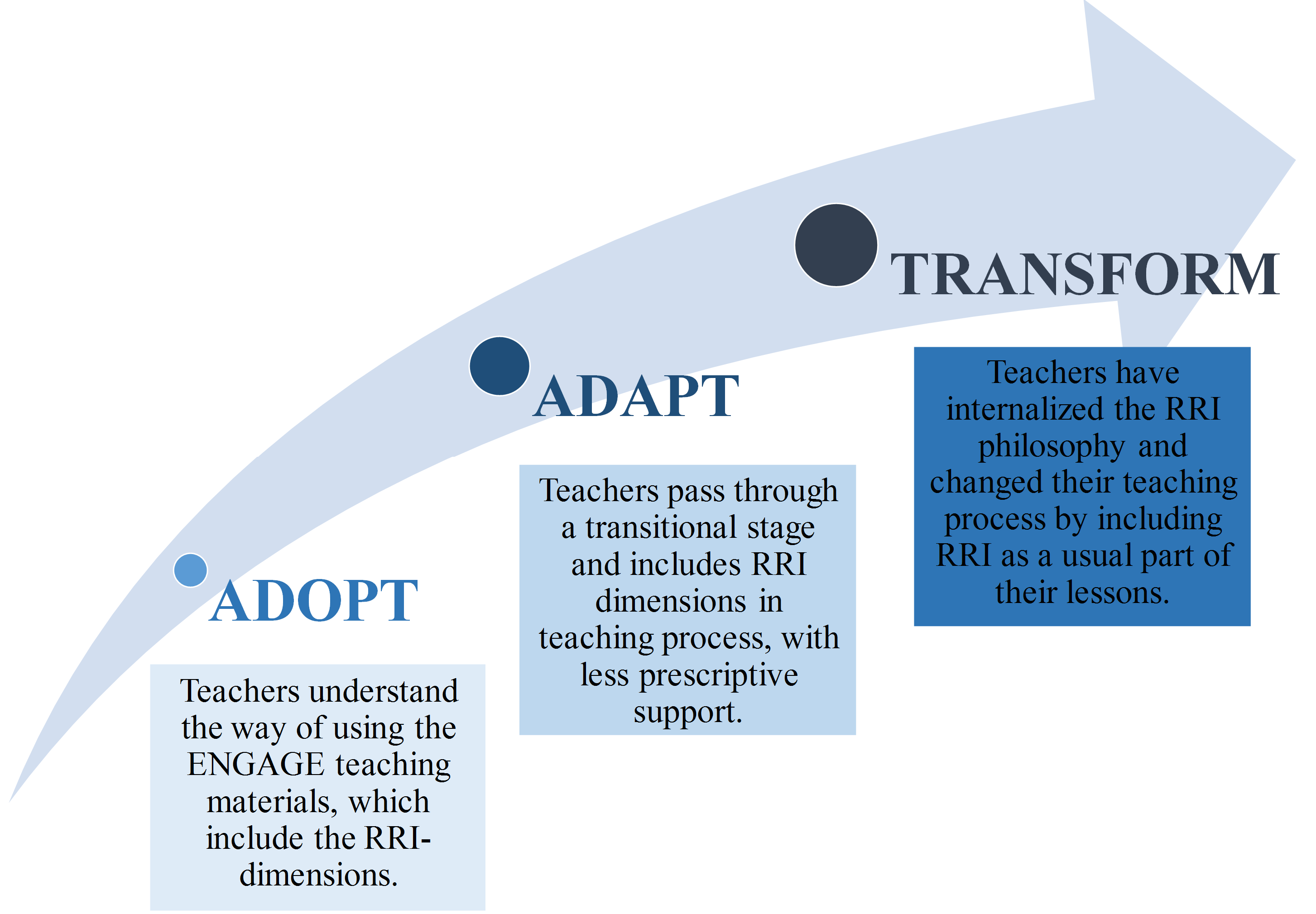
Results and Discussions
Like all the ENGAGE partners, Valahia University Targoviste (VUT) team organized face-to-face workshops with Science teachers (Chemistry, Physics and Biology) from different counties of Romania (Dâmbovița, Buzău, Ialomița, Iași, Suceava) to help teachers to understand what RRI concept consists of and how the key aspects of this concept can be introduced in Science lessons in order to make them more attractive for the students. Till present, about 170 in-service Science teachers attended the workshops organized in Romania. Figure
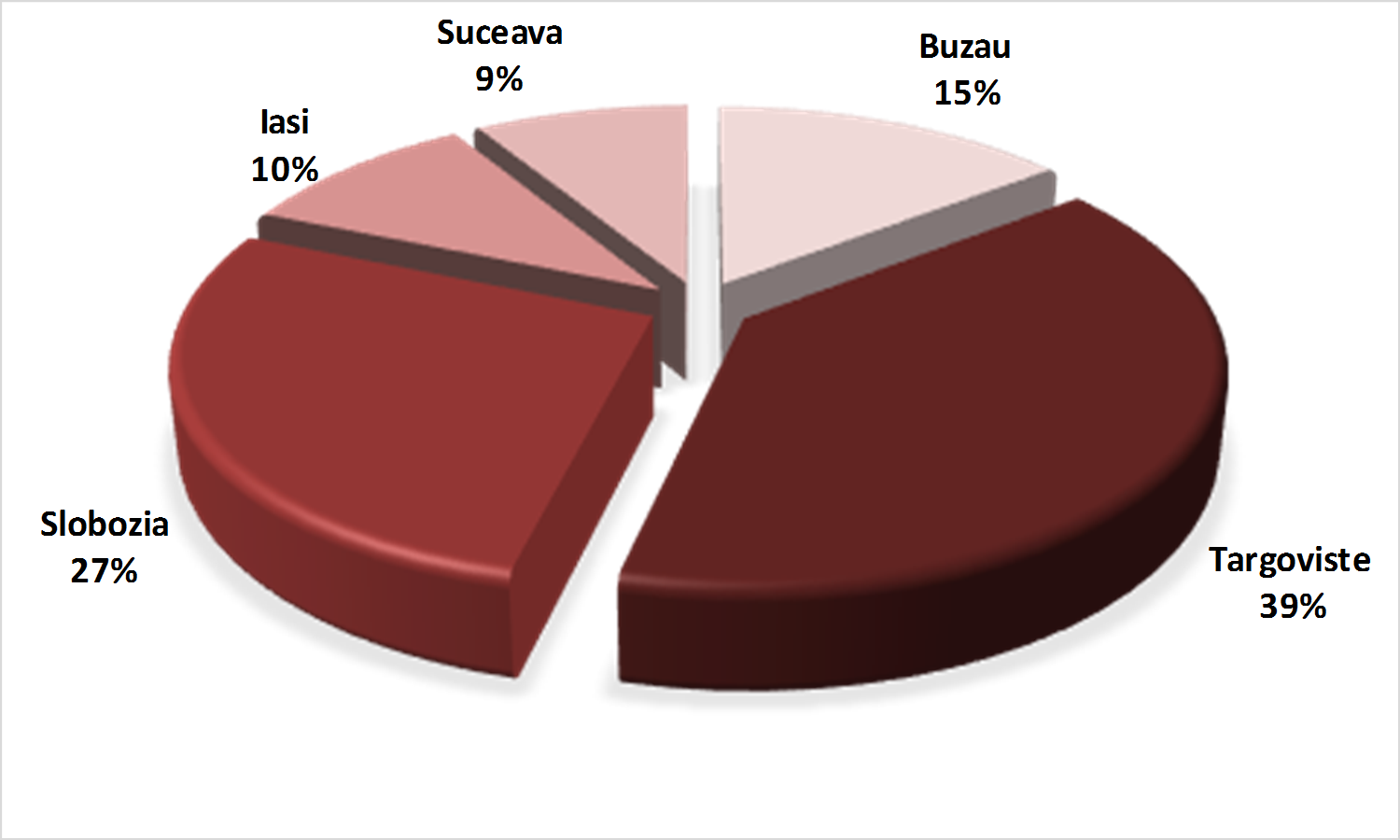
The target group characteristics are illustrated in figures
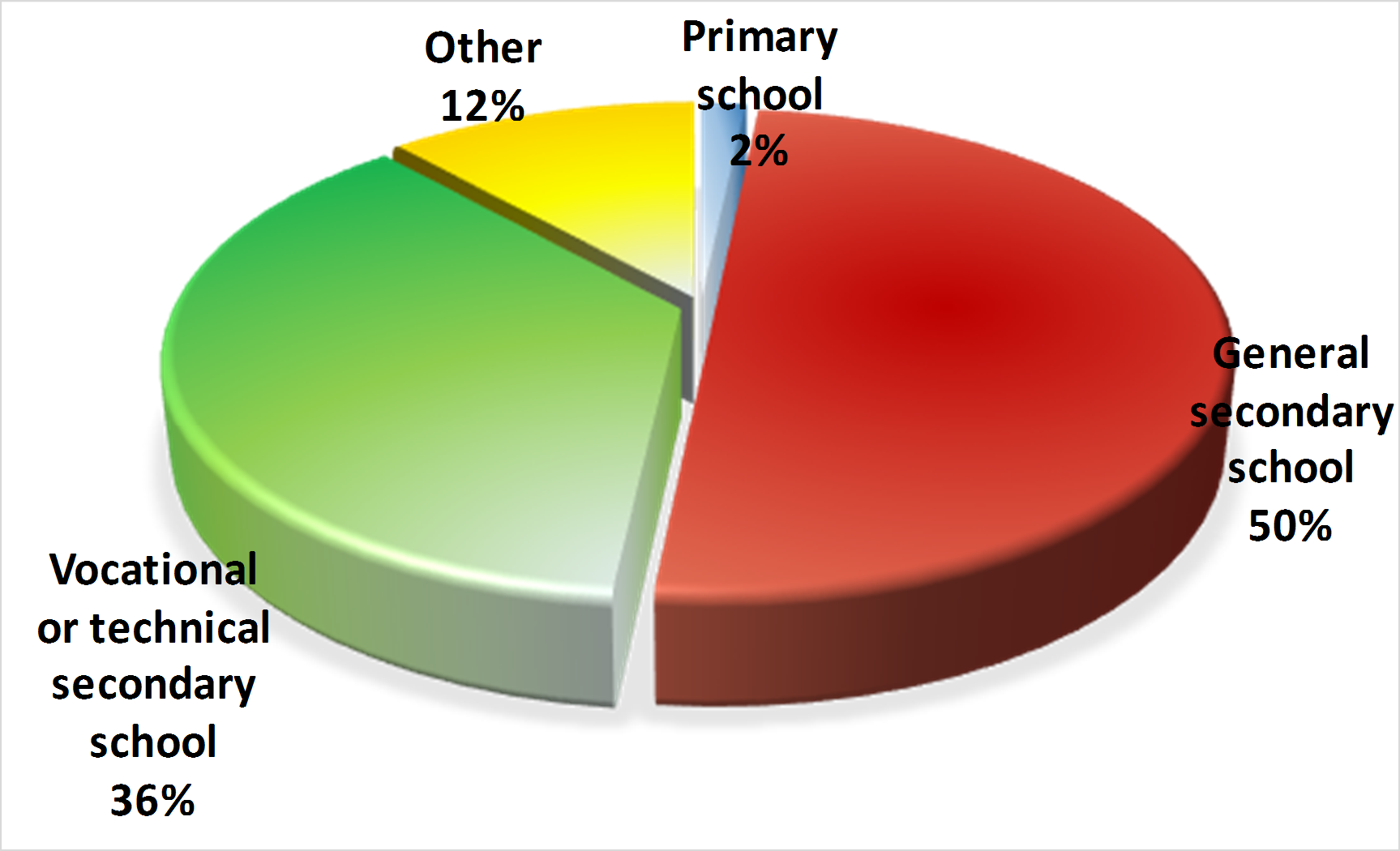
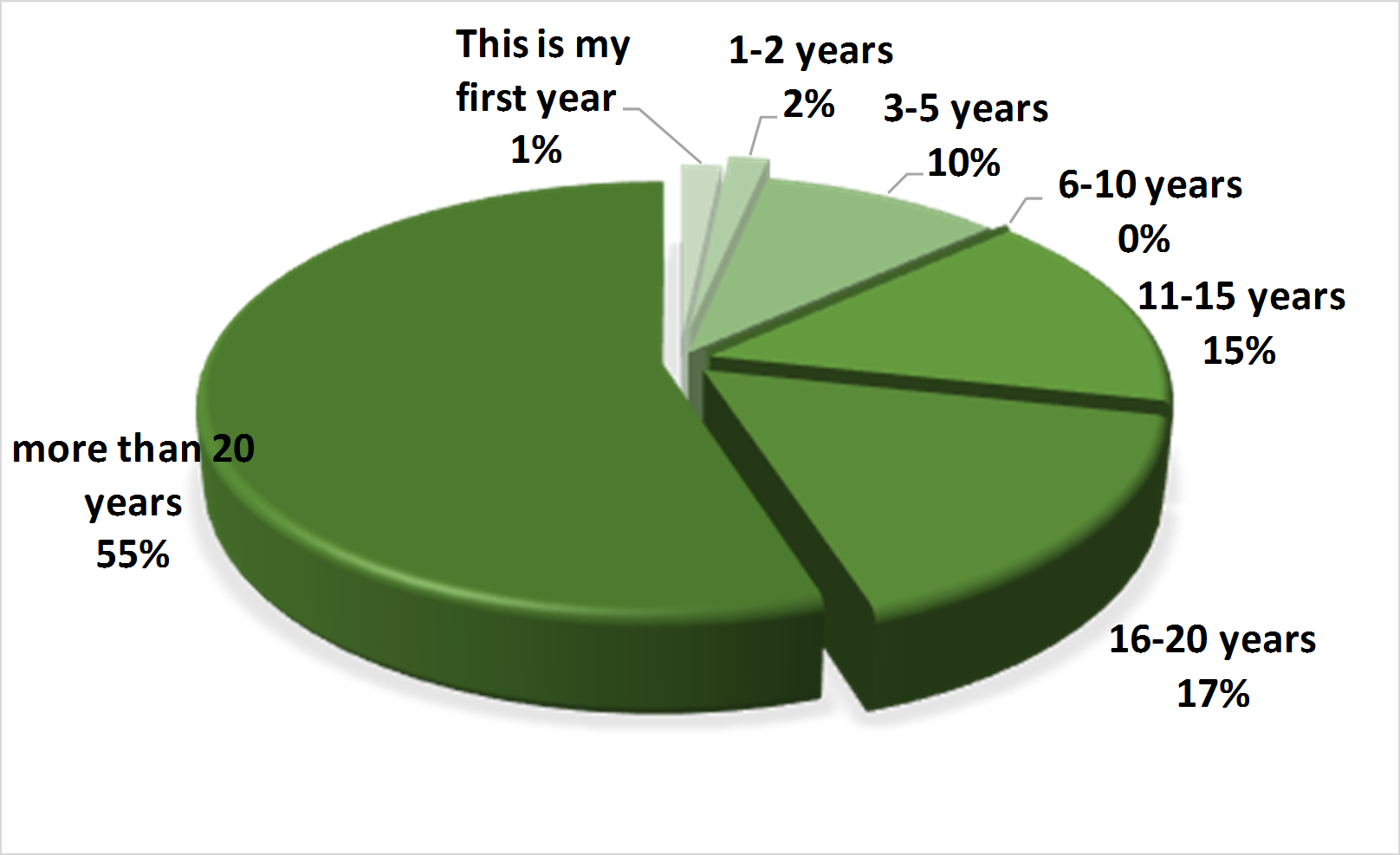
A big part of the participants was involved in the on-line courses organized by Valahia University Targoviste for the first 2 stages of the CPD programme (ADOPT and ADAPT). Since the ENGAGE project will be finished in March 2017, the activities devoted to the 3rd step of the CPD programme (TRANSFORM) are planned for the period September 2016 - February 2017.
After the workshop sessions, the VUT team was interested to identify the teachers’ perception concerning the possibility to introduce the RRI dimensions in Science lessons, taking into consideration the Romanian educational context. Thus, relevant information was collected with the help of a reflection sheet applied at the end of the workshop. The reflection sheet was divided in two sections, one focused on the teachers’ perceptions related to what they learned during the workshop and the second was devoted to capture the teachers’ feedback concerning the effects that workshop will have on their subsequent teaching activity. In the following paragraphs, a short analysis of the teachers’ feedback is presented. Inside of the reflection sheet, there were introduced items with open-answers, items with multiple answers, items with five and four pre-coded response options, and items structured on a five-step Likert scale. Based on this large range of items, the VUT team can obtain important information concerning the possibility to implement the RRI aspects in Science teaching. The fulfilling of reflection sheets took place in appropriate conditions of confidentiality and representativeness. The obtained data were processed by statistical and mathematical analysis corroborated with qualitative assessment resulting from discussions with teachers.
Figure
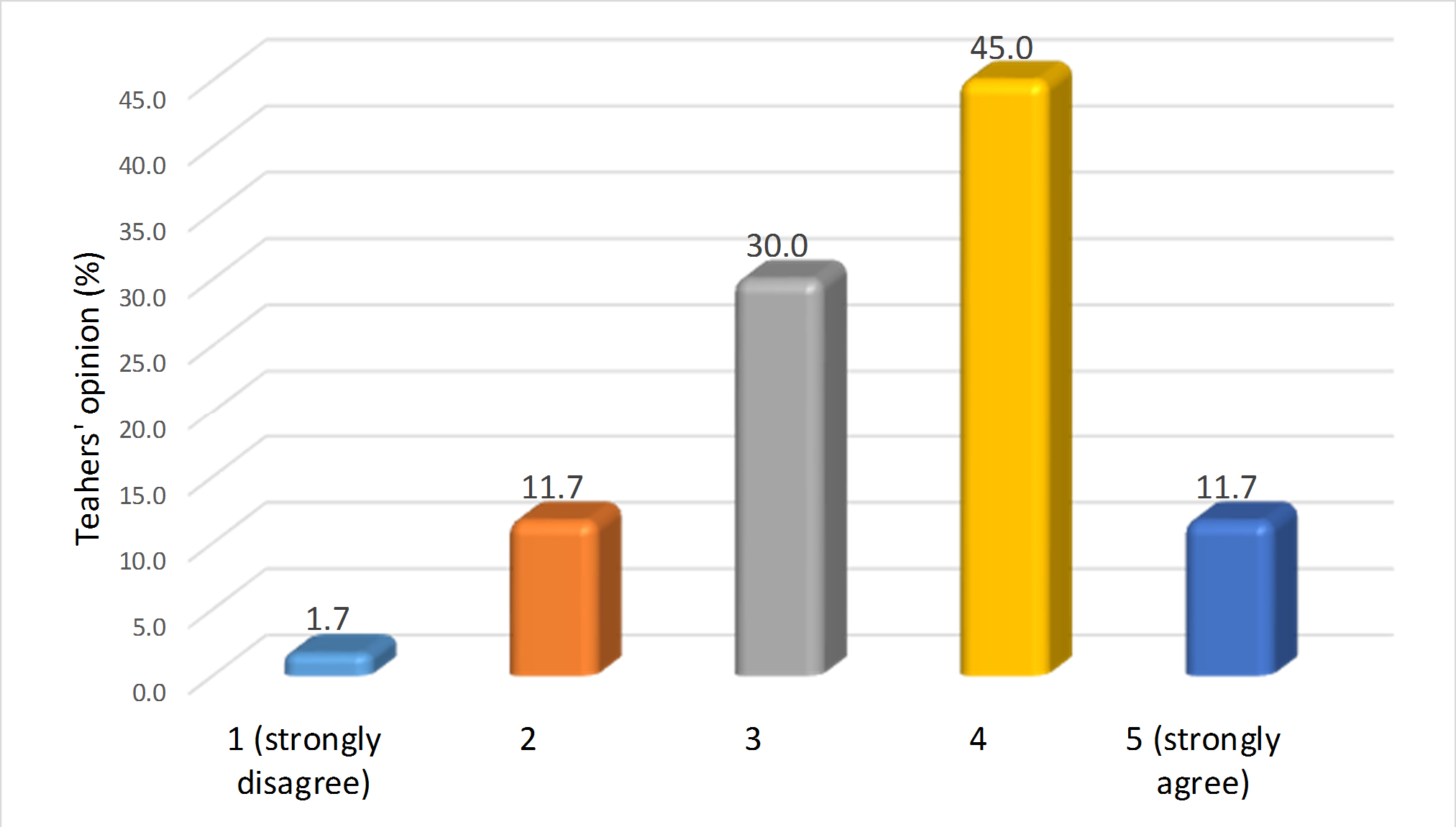
Having a short view to the previous figure, the teachers claimed they know the needed steps, but the problem is how many of them really follow those steps in order to make the connection between the scientific topics and their impact to the societal level.
Considering the fact that during the workshop it was introduced the socio-scientific dilemma as a teaching method, one of the questions placed in the reflection sheet was: “
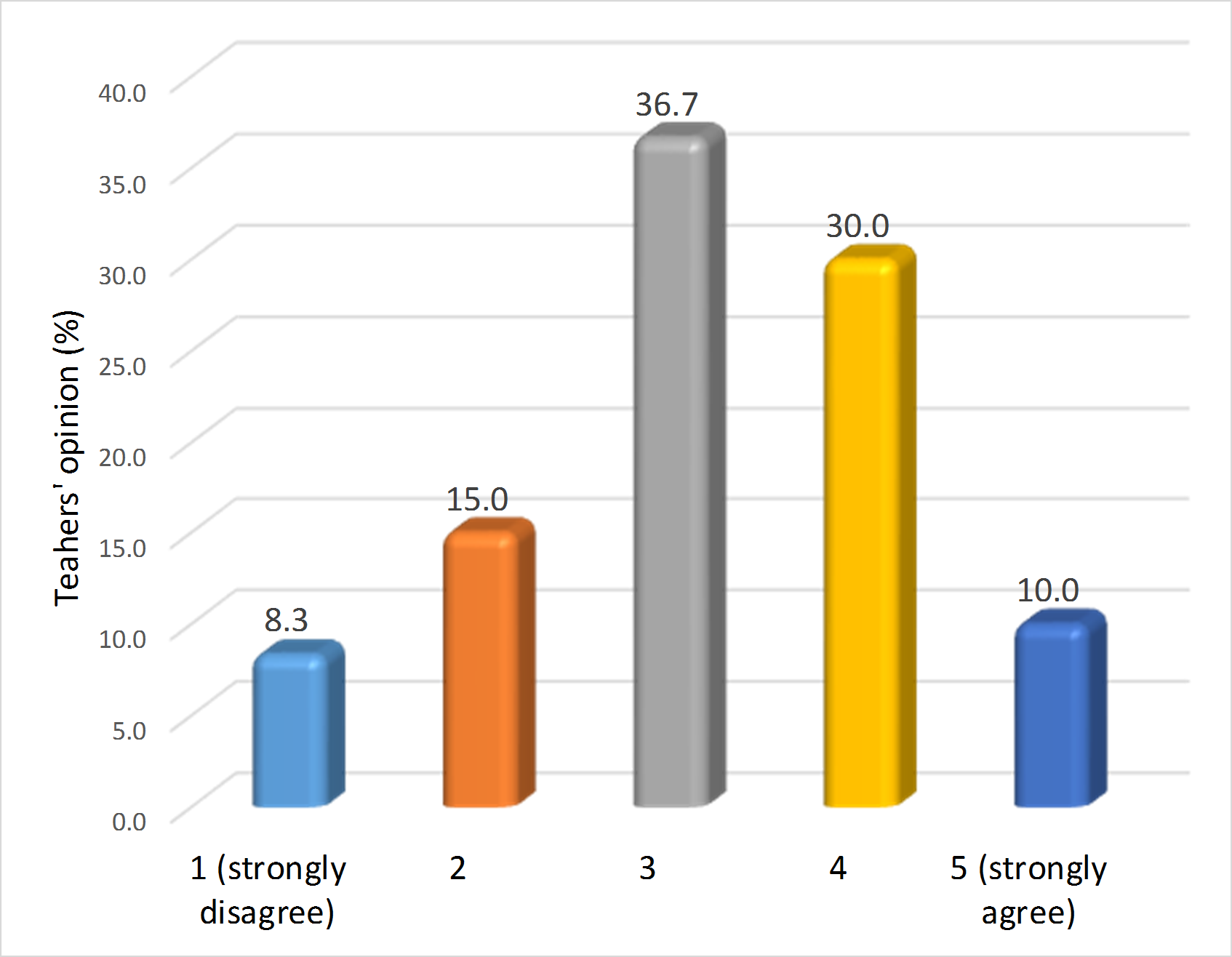
Taking into consideration the Romanian educational context and the curriculum limitations, most of the teachers probably used “dilemma” in a scientific and not in a socio-scientific way. The novelty of the “socio-scientific dilemma” consists of how to connect the scientific news with their impact on the social and ethical level. In the discussions held between organizers and participants which took place in the end of each workshop session, we collected the information that most of the teachers connected the dilemma only with the scientific aspects of the problem and they didn’t reach the social aspects, or more, the ethical aspects. Most of them claimed the time limitation in order to scroll through the entire syllabus.
Being asked about the educational outcomes expected to be registered by the students from the classes where they will apply the knowledge achieved during the workshop, the teachers considered that those results will be improved very much (38%), much (55%) and moderate (7%). Those teachers’ expectations can be attributed to the development in Educational Sciences in general (curriculum paradigm, student-centred paradigm etc.) and Science Education in particular (Responsible Research and Innovation (RRI), Problem Based Learning (PBL), Inquiry Based Science Education (IBSE), integrated approaches etc.).
Moving to the item focused on identifying the aspects that teachers considered to have the biggest impact on the students’ learning process, the answers were again split in few directions (Fig. 7). The teachers’ opinions emphasized that from the perspective of optimizing the teaching approach as a result of participation to those workshops, the most important aspects were related on how to integrate RRI in Science teaching, by using dilemma lessons (28.7%) and the collection of the ENGAGE curriculum materials given as examples to integrate RRI aspects in the Science lessons (24.6%). The teachers appreciated that curriculum materials represent good examples for connecting the theory with practice (16.4%).
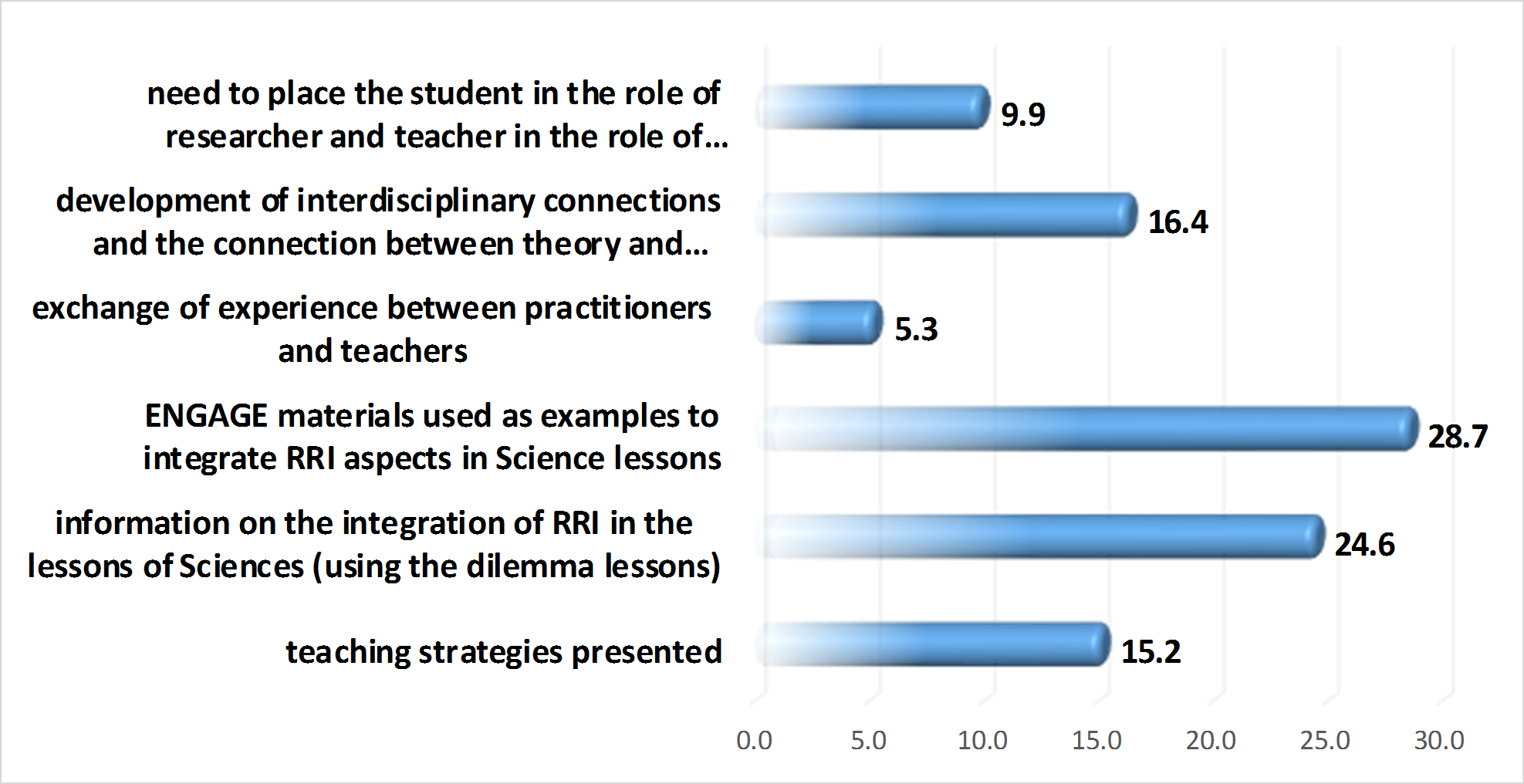
Conclusions
The results obtained at the end of different editions of the ENGAGE workshop, correlated with data gathered through discussions with teachers involved in those activities organized in the frame of the ENGAGE project, led to the idea that in order to implement the RRI key aspects in Science lessons and to form the investigative, resolutive or decision-making skills to the Romanian students, a deep process of reform have to take place in the national curriculum for Chemistry, Physics and Biology. This process has to involve all the basic components: objectives, outcomes, content, teaching methodologies, evaluation and training time.
The Romanian teachers’ feedback demonstrates that most of the Science teachers recognize the need and claim for a real reform in the teaching process of scientific disciplines, in accordance with the European Community policies and having in view the new type of responsible citizens that must graduate the studies in this period.
Acknowledgements
This work was funded through the Seventh Framework Programme Project “ENGAGE - Equipping the Next Generation for Active Engagement in Science Project” - a coordination and support action under FP7-Science-in-Society-2013-1, Activity 5.2.2 “Young people and science” - Topic SiS.2013.2.2.1-1: Raising youth awareness to Responsible Research and Innovation through Inquiry Based Science Education.
This project has received funding from the European Union’s Seventh Framework Programme for research, technological development and demonstration, under grant agreement no 612269. The support offered by the European Commission, through the project mentioned above, is gratefully acknowledged.
References
- Dwyer, D.C., Ringstaff, C., & Sandholtz, J. H. (1991). Changes in Teachers Beliefs and Practices in Technology - Rich Classrooms. Educational Leadership, 48(8), 45-54, http://www.ascd.org/ASCD/pdf/journals/ed_lead/el_199105_dwyer.pdf, accessed 2016-06-30.
- European Commission Decision (2015). HORIZON 2020 Work Programme 2014-2015. Science with and for Society. https://ec.europa.eu/research/participants/data/ref/h2020/wp/2014_2015/main/h2020-wp1415-swfs_en.pdf, accessed 2016-06-30.
- European Union. (2014). Responsible Research and Innovation. Europe’s ability to respond to societal challenges. https://ec.europa.eu/research/swafs/pdf/pub_rri/KI0214595ENC.pdf, accessed 2016-06-30.
- Gorghiu, L. M., & Gorghiu G. (2014). Related Aspects on Using Digital Tools in the Process of Introducing Nanotechnology in Science Lessons. Acta Physica Polonica A, 125(2), 544-547.
- Petrescu, A. M. A., Gorghiu L. M., & Dumitrescu C. (2015). The ENGAGE Project - A Facilitator Context for Promoting Responsible Research and Innovation in Science Lessons. Central & Eastern European LUMEN Conference: LUMEN NASHS 2015: Chisinau, Republic of Moldova: 11-13 September 2015, published in Central and Eastern European LUMEN Conference: New Approaches in Social and Humanistic Sciences: NASHS 2015, Bologna: Medimond International Proceedings, p. 405-411
- Strategic Framework for European Cooperation in Education and Training ('ET 2020'), Council Conclusions May 2008, OJL 119, 28.5.2009
- Sutcliffe, H. (2011). A Report on Responsible Research and innovation. DG Research and Innovation, European Commission. https://ec.europa.eu/research/science-society/document_library/pdf_06/rri-report-hilary-sutcliffe_en.pdf, accessed 2016-06-30.
- Vassiliou, A. (2011). Science Education in Europe: National Policies, Practices and Research. EACEA P9 Eurydice. http://eacea.ec.europa.eu/education/eurydice/documents/thematic_reports/133en.pdf, accessed 2016-06-30.
Copyright information

This work is licensed under a Creative Commons Attribution-NonCommercial-NoDerivatives 4.0 International License.
About this article
Publication Date
22 December 2016
Article Doi
eBook ISBN
978-1-80296-017-4
Publisher
Future Academy
Volume
18
Print ISBN (optional)
-
Edition Number
1st Edition
Pages
1-672
Subjects
Teacher, teacher training, teaching skills, teaching techniques, special education, children with special needs
Cite this article as:
Gorghiu, L. M., Dumitrescu, C., & Petrescu, A. A. (2016). Introducing RRI in Science Teaching - An Actual Challenge for Science Teachers. In V. Chis, & I. Albulescu (Eds.), Education, Reflection, Development - ERD 2016, vol 18. European Proceedings of Social and Behavioural Sciences (pp. 183-191). Future Academy. https://doi.org/10.15405/epsbs.2016.12.25

